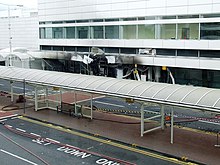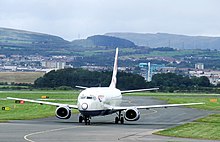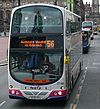Glasgow Airport: Difference between revisions
→Airlines and destinations: Also need references |
|||
| Line 148: | Line 148: | ||
|[[Monarch Airlines|Monarch]]| '''Seasonal:''' [[Orlando Sanford International Airport|Orlando-Sanford]] | 1 |
|[[Monarch Airlines|Monarch]]| '''Seasonal:''' [[Orlando Sanford International Airport|Orlando-Sanford]] | 1 |
||
|[[Onur Air]]| '''Seasonal:''' [[Milas-Bodrum Airport|Bodrum]], [[Dalaman Airport|Dalaman]] | 1 |
|[[Onur Air]]| '''Seasonal:''' [[Milas-Bodrum Airport|Bodrum]], [[Dalaman Airport|Dalaman]] | 1 |
||
|[[Pakistan International Airlines]] |[[Allama Iqbal International Airport|Lahore]] | |
|||
|[[SunExpress]] | '''Seasonal:''' [[Antalya Airport|Antalya]] | 1 |
|[[SunExpress]] | '''Seasonal:''' [[Antalya Airport|Antalya]] | 1 |
||
|[[Sunwing Airlines]] | '''Seasonal:''' [[Toronto Pearson International Airport|Toronto-Pearson]] [begins 14 June 2012] | 1 |
|[[Sunwing Airlines]] | '''Seasonal:''' [[Toronto Pearson International Airport|Toronto-Pearson]] [begins 14 June 2012] | 1 |
||
Revision as of 17:04, 1 May 2012
Glasgow International Airport Port-adhair Eadar-nàiseanta Ghlaschu | |||||||||||
|---|---|---|---|---|---|---|---|---|---|---|---|
| File:BAA Glasgow logo.png | |||||||||||
 | |||||||||||
| Summary | |||||||||||
| Airport type | Public | ||||||||||
| Owner/Operator | BAA Limited | ||||||||||
| Serves | Glasgow, Scotland and UK | ||||||||||
| Location | Renfrewshire | ||||||||||
| Hub for | Loganair | ||||||||||
| Elevation AMSL | 26 ft / 8 m | ||||||||||
| Website | www.glasgowairport.com | ||||||||||
| Map | |||||||||||
| Runways | |||||||||||
| |||||||||||
| Statistics (2011) | |||||||||||
| |||||||||||
Glasgow International Airport (Scottish Gaelic: Port-adhair Eadar-nàiseanta Ghlaschu) (IATA: GLA, ICAO: EGPF) (formerly Glasgow Abbotsinch Airport) is an international airport in Scotland, located 6 nautical miles (11 km; 6.9 mi) west[1] of Glasgow city centre, near the towns of Paisley and Renfrew in Renfrewshire. In 2011 the airport handled nearly 6.9 million passengers, a 5.1% annual increase, making it the second busiest in Scotland, after Edinburgh Airport, and the eighth busiest airport in the United Kingdom.
The airport is owned and operated by BAA, which also owns and operates five other UK airports,[4] and is itself owned by ADI Limited, an international consortium, which includes Caisse de dépôt et placement du Québec and GIC Special Investments, that is led by the Spanish Ferrovial Group.[5] The Airport is a base for airlines such as BMI Regional, EasyJet, Flybe and Loganair, Jet2, Thomas Cook Airlines and Thomson Airways, and also houses maintenance facilities for British Airways.
Glasgow Airport was first opened in 1966 and originally only facilitated flights to other places in the United Kingdom and Europe. The British Airports Authority (BAA) took control of the airport in 1975 and when BAA was privatised in the 1980s, Glasgow Airport began to offer flights to other places around the world, flights which previously were facilitated by Glasgow Prestwick Airport. The airport was the target of a terrorist attack on June 30, 2007, when a Jeep Cherokee loaded with propane canisters was driven into the main terminal building, causing some damage.
History

The history of the present Glasgow Airport goes back to 1932, when the site at Abbotsinch, between the Black Cart Water and the White Cart Water, near Paisley in Renfrewshire, was opened and the Royal Air Force 602 Squadron (City of Glasgow) Auxiliary Air Force moved its Wapiti IIA aircraft from nearby Renfrew in January 1933.[6] The RAF Station HQ, however, was not formed until 1 July 1936 when 6 Auxiliary Group, Bomber Command, arrived.[6] From May 1939, until moving away in October 1939, the Squadron flew the Supermarine Spitfire.
1940
In 1940, a torpedo training unit was formed, which trained both RAF and Royal Navy crews.[6] On 11 August 1943 Abbotsinch was handed over solely to the Royal Navy and it became a naval base. All Her Majesty's Ships and naval bases are given names and Abbotsinch's was known as HMS Sanderling since June 1940.[6] During the 1950s, the airfield housed a large aircraft storage unit and squadrons of the Royal Naval Volunteer Reserve.
The Royal Navy left in October 1963.[6] The name Sanderling was however retained as a link between the two: HMS Sanderling's ship's bell was presented to the new airport and a bar in the airport was named The Sanderling Bar.
1960s

In the 1960s, Glasgow Corporation decided that a new airport for the city was required. The original site of Glasgow's main airport was 3 km (1.9 mi) east of Abbotsinch, in what is now the Dean Park area of Renfrew. The original Art Deco terminal building of Renfrew Airport has not survived. The site is now occupied by a Tesco supermarket and the M8 motorway; this straight and level section of motorway occupies the site of the runway.[7]
Abbotsinch took over from Renfrew airport on 2 May 1966.[6][7] The UK Government had already committed millions into rebuilding Prestwick Airport fit for the "jet age". Nevertheless, the plan went forward and the new airport, designed by Basil Spence and built at a cost of £4.2 million, was completed in 1966, with British European Airways beginning services using De Havilland Comet aircraft.
The first commercial flight to arrive was a British European Airways flight from Edinburgh, landing at 8 am on 2 May 1966. The airport was officially opened on 27 June 1966 by Queen Elizabeth II. The political rows over Glasgow and Prestwick airports continued, with Prestwick enjoying a monopoly over transatlantic traffic, while Glasgow Airport was only allowed to handle UK and intra-European traffic.
1970s to date


In 1975, the BAA took ownership of Glasgow Airport. When BAA was privatised in the late 1980s, as BAA plc, it consolidated its airport portfolio and sold Prestwick Airport. The restrictions on Glasgow Airport were lifted and the transatlantic operators immediately moved from Prestwick, Glasgow Airport being renamed Glasgow International Airport. BAA embarked on a massive redevelopment plan for Glasgow International Airport in 1989.
An extended terminal building was created by building a pre-fabricated metal structure around the front of the original Basil Spence building, hence screening much of its distinctive Brutalist style architecture from view, with the void between the two structures joined by a glass atrium and walkway. Spence's original concrete facade which once looked onto Caledonia Road now fronts the check-in desks. The original building can be seen more clearly from the rear, with the mock barrel vaulted roof visible when airside.
A dedicated international departure lounge and pier was added at the western side of the building, leaving the facility with a total of 38 gates, bringing its capacity up to nine million passengers per year. In 2003, BAA completed redevelopment work on a satellite building (called "T2", formerly the St. Andrews Building), in order to provide a dedicated check-in facility for low cost airlines, principally Aer Lingus,Virgin Atlantic Airways and Thomas Cook Airlines.
By 1996, Glasgow International was handling over 5.5 million passengers per annum, making it the fourth largest airport in the UK.[8]
Today
The terminal has three piers: West (International), Central (Domestic) and East (Low-cost, Ireland & Scottish islands).
The Central Pier, which was part of the original 1966 building, is now used for domestic destinations. British Airways is based in the 1971 extension to the end of the pier, with Heathrow and Gatwick shuttles making up most of its traffic. There are two BA Executive Club lounges. BMI and Flybe also use the Central Pier.
The East Pier, constructed in the mid 1970s, was originally used for international flights but in recent years has been redeveloped for use by EasyJet and Loganair as well as some charters. Most flights to Ireland and Northern Ireland also use this pier. None of the stands on this pier are provided with airbridges. The major users of this pier are Aer Lingus, Loganair and EasyJet.


The West Pier, built as part of the 1989 extension project, is the principal international and long haul departure point, with some gates capable of handling Boeing 747 aircraft. The largest aircraft currently regularly using the airport are the Emirates Boeing 777-300ER. In early 2006, a redevelopment of the International Departure Lounge took place including the provision of a new business/premium lounge. [citation needed]
Work commenced in late 2007,[9] on Skyhub (located between the Main Terminal and Terminal 2)[10] which created a single, purpose built security screening area in place of the previous individual facilities for each of the three piers, the other side effect being an enlargened duty free shopping area created by taking most of the previous landside shopping and restaurant facilities airside. This new arrangement also frees up space in the departure lounges through the removal of the separate duty free shops in the West and Central Piers. The side effect of this however is that the former public viewing areas of the apron are now airside, making the airport inaccessible to aviation enthusiasts and spectators.
Further growth is hampered by the airport's location, which is constrained by the M8 motorway to the south, the town of Renfrew to the east and the River Clyde to the north. At present the towns of Clydebank, Bearsden and Linwood all sit directly underneath the approach paths into the airport, meaning that further increases in traffic may be politically sensitive. Glasgow International also faces stiff competition from Glasgow Prestwick Airport, which has reinvented itself as a low-cost hub for budget airlines and which has a direct rail link to Central Glasgow. The Scottish Executive announced in 2002 that a rail line - known as the Glasgow Airport Rail Link (GARL) - would be built from Glasgow Central station to Glasgow International Airport. The rail link was to be completed by 2012 with the first trains running early in 2013. In 2009, however, it was announced by the Scottish Government that the plan had been cancelled.[11]
Currently, the airport is easily accessed by road due to the adjoining M8 motorway and is served by a frequent and dedicated express bus (the "Glasgow Flyer") from the city centre. The service is run by First Glasgow under contract to BAA.





The airport is home to the Scottish regional airline Loganair, currently a Flybe franchise operator, who have hangar facilities[citation needed] as well as their head office located on site.[12] British Airways has a maintenance hangar at the airport, capable of carrying out overhaul work on Airbus A320 and Boeing 737 aircraft, as well as a cargo facility.
The Royal Air Force also has a unit based within the airport - The Universities of Glasgow and Strathclyde Air Squadron - to provide flying training to university students who plan to join the RAF.
In 2007, Glasgow International became the second busiest airport in Scotland as passenger numbers were surpassed by those at Edinburgh Airport.
Icelandair temporarily moved its base of operations from Keflavík International Airport to Glasgow due to the 2010 eruptions of Eyjafjallajökull.
Plans
In 2005 BAA published a consultation paper[13] for the development of the airport. The consultation paper included proposals for a second runway parallel to and to the north-west of the existing runway 05/23; redevelopment and enlargement of the East (low-cost) pier to connect directly with Terminal 2; and an additional International Pier to the west of the existing International Pier. There were plans for a new rail terminal, joined to the airport's passenger terminal and multi-storey car park. On 29 November 2006 the Scottish Parliament gave the go-ahead for the new railway station as part of the Glasgow Airport Rail Link to Glasgow Central station, originally due for completion in 2011. However on 17 September 2009, due to escalating costs, the project was cancelled by the Scottish Government.[14]
BAA's plans, which are expected to cost some £290 million over the next 25 years, come in response to a forecasted trebling of annual passenger numbers passing through the airport by 2030. The current figure of 8.8 million passengers passing through the airport is expected to rise to more than 24 million by 2030.
Airlines and destinations






Cargo
| Airlines | Destinations |
|---|---|
| FedEx Feeder operated by Swiftair | London-Stansted, Newcastle, Paris-Charles de Gaulle |
2011 traffic statistics
| Rank | Airport | Passengers handled | % Change 2010 / 11 |
|---|---|---|---|
| 1 | 820,949 | ||
| 2 | 562,787 | ||
| 3 | 342,887 | ||
| 4 | 298,795 | ||
| 5 | 275,016 | ||
| 6 | 274,576 | ||
| 7 | 248,253 | ||
| 8 | 224,768 | ||
| 9 | 222,161 | ||
| 10 | 206,869 | ||
| 11 | 200,722 | ||
| 12 | 188,557 | ||
| 13 | 149,709 | ||
| 14 | 149,434 | ||
| 15 | 139,544 | ||
| 16 | 122,245 | ||
| 17 | 119,211 | ||
| 18 | 118,324 | ||
| 19 | 104,517 | ||
| 20 | 103,434 |
The airport handled 6,867,444 passenger movements in 2011.
Accidents and incidents
- On 3 September 1999, a Cessna 404 carrying nine Airtours staff from Glasgow to Aberdeen on a transfer flight, crashed minutes after take off near the town of Linwood, Renfrewshire. Eight people were killed and three seriously injured. No one on the ground was hurt. A fatal accident inquiry into the accident later found that the aircraft developed an engine malfunction during take off. Although the captain decided to return to the airfield, he mistakenly identified the working engine as the faulty one and shut it down, causing the aircraft to crash.
- On 30 June 2007, a day after the failed car bomb attacks in London, an attack at Glasgow International Airport occurred. A flaming Jeep Cherokee was driven into the entrance of Terminal 1. Two men, one alight, fled the vehicle before being apprehended by a combination of police officers, airport security officers and witnesses. One of the men died in the following months due to injuries sustained in the attack.
Ground transport

The airport is currently linked to Glasgow City Centre by Glasgow Shuttle bus service 500. This is run by First Glasgow under contract to BAA. Started in 2011, the service runs 24 hours a day, direct via the M8 motorway. Prior to this, Arriva Scotland West ran the 500 as the Glasgow Flyer, which started in 2007, but they have since lost the contract to provide airport services. This service still runs in competition with the First/BAA offering, but has been moved from the main arrivals bus stop. Before 2007, Arriva and Fairline Coaches ran this service as route 905, under contract to Scottish Citylink, and this ended following the introduction of the Flyer. Fairline later introduced a new Glasgow Airport Link service using the old route 905 number, but this has since been dropped and replaced by First Bus as the 747 route.
References
- Notes
- ^ a b Glasgow - EGPF
- ^ CAA: UK Annual Airport Statistics
- ^ BAA Glasgow: Contact Us
- ^ UK airports owned and operated by BAA
- ^ BAA: "Who we are"
- ^ a b c d e f Smith, Abbotsinch
- ^ a b Smith, Renfrew
- ^ CAA Terminal & Transit Passengers at UK Airports - 1996
- ^ "Skyhub ready for take-off as construction phase begins". Retrieved 2007-10-30.
- ^ "Glasgow Airport aiming sky high with £30m expansion". Retrieved 2007-10-30.
- ^ Ministers scrap airport rail plan
- ^ "Statutory Information." Loganair. Retrieved on 20 May 2009. "Registered Office: St. Andrews Drive, Glasgow Airport PAISLEY Renfrewshire PA3 2TG"
- ^ consultation paper
- ^ [1] [dead link]
- ^ France Travel Services
- ^ Table 12 1 Intl Air Pax Route Analysis 2010
- Bibliography
- McCloskey, Keith. Glasgow's Airports: Renfrew and Abbotsinch. Stroud, Gloucestershire, UK: The History Press Ltd., 2009. ISBN 978-0-7524-5077-3.
- Smith, David J. Action Stations, Volume 7: Military airfields of Scotland, the North-East and Northern Ireland. Cambridge, Cambridgeshire, UK: Patrick Stephens Ltd., 1983 ISBN 0-85059-563-0.




